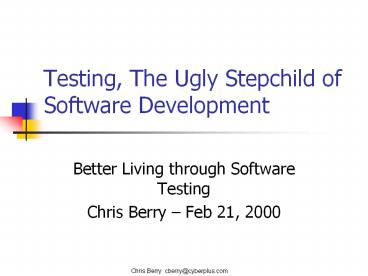Testing, The Ugly Stepchild of Software Development PowerPoint PPT Presentation
Title: Testing, The Ugly Stepchild of Software Development
1
Testing, The Ugly Stepchild of Software
Development
- Better Living through Software Testing
- Chris Berry Feb 21, 2000
Chris Berry cberry_at_cyberplus.com
2
Why Test?
- Its easy to fool yourself.
- Increase confidence.
- Increase productivity.
- Increase courage.
- It simply makes programming more fun!
3
Test Early, Test Often
- Defects are order of magnitude cheaper to fix
when programmers find their own errors. - No communication cost.
- The bug tracking system does not become involved.
- The error does not block or corrupt the work of
other developers.
4
Preemptive Testing
- The Art of catching bugs before they happen.
- Defensive Programming.
- Programming by Contract.
5
The Assertion
- The hallmark of Defensive Programming.
- Allows you to assert that a particular condition
is met, and commonly, if it is not, terminate
execution. - Pre and post conditions.
- Not to be confused with Exceptions.
6
(No Transcript)
7
Sanity Checking
- A simple coding convention which requires all
Classes to provide a boolean isSane method. - Used to determine whether a particular Instance
is in a sane state.
8
Logging/Debug Prints
- Low tech debugging technique. Often the only way
to debug threaded code. - Can speed development.
- Permanent artifact.
- Can result in Scroll-blindness. Best to divert
logging to a file rather than standard out. - The log4j package for Java.
9
Unit Testing
- Test each unit of code independently.
- In OO, this equates to testing a Class and its
public interface. - Involves debugging, simultaneously, the code, the
test, and the Spec.
10
Unit Testing is Glass Box Testing
- You Must be aware of
- All branches of the method under test.
- What inputs should produce what results or
Exceptions. - The interplay of affected member variables and
arguments.
11
Building a Good Unit Test
- Test for
- Data integrity
- Valid input Insure that correct outputs are
generated for correct input conditions. - Invalid input Insures proper error handling.
12
Deciding on Unit Test Input
- Equivalence Partitioning.
- Good partitioning gives rigor without redundancy.
- Boundary Analysis
- Things go wrong at the edges.
- Expected and unexpected Exceptions.
13
Equivalence Partitioning
- An equivalence class is a definition of a group
of inputs, any one of which should be treated
exactly the same by the method under test. - Eliminates redundant tests. The behavior of the
method should be equivalent so only one test
need be run for any equivalence class.
14
Boundary Analysis
- The term for choosing the appropriate values to
test a particular equivalence subset. - Choose values at the edge of the set.
- Also a good idea to include the transition
values.
15
Dealing with Exceptions
- Catch all unplanned Exceptions.
- Match all thrown Exceptions with the conditions
expected to produce them.
16
Classic Unit Test construct
- Generate argument providers
- Loops over all argument providers
- Construct the Object under test (OUT)
- Optionally save the state of the OUT
- Call the method under test (MUT)
- If an exception was generated
- Test for unhandled exceptions
- Else
- Assertions on the resultant, OUT, and
arguments - End loops
17
Integration Testing
- Tests which prove that the program properly
executes some required functionality. - Typically involves the integration of many
Classes. - Often a test from the perspective of the customer.
18
eXtreme Programming
- A lightweight, low-risk, flexible, predictable,
and fun way to develop software. - Takes commonsense best practices and applies them
to an extreme degree.
19
XP in a Nutshell
- Code is king.
- Embrace change.
- Constant design.
- Emphasis on refactoring.
20
The Four Variables
- Cost
- Time
- Quality
- Scope.
21
The Four Values of XP
- Communication
- Simplicity
- Feedback
- Courage.
22
Central Principles of XP
- Rapid Feedback.
- Assume Simplicity.
- Incremental change.
- Embrace change.
- Quality work.
23
Secondary Principles of XP
- Teach Learning.
- Small Initial Investment.
- Play to Win.
- Concrete Experiments.
- Honest communication.
24
Secondary Principles of XP, continued
- Work with instincts.
- Accepted responsibility.
- Local adaptation.
- Travel Light.
- Honest measurement.
25
Four Basic Activities of XP
- Coding.
- Testing.
- Listening.
- Designing.
26
XP Development Practices
- On-site Customer
- System Metaphor
- Pair Programming
- Tests Before Code
- Simple Design
27
XP Development Practices, continued
- Merciless Refactoring
- Continuous Integration
- Collective Ownership
- Coding Standards
28
Testing the XP way
- A simplified, pragmatic, and less rigorous
approach to testing. - Tests things that might break. Testing simple
methods, like accessors, is valueless. - Write the tests first.
- Keep the tests running.
- Tests are automatic. Run the full suite several
times a day. - JUnit, a Java testing framework. A C version
(CPPUnit) is now available.
29
(No Transcript)
30
Summary
- The earlier you catch a bug the less it is going
to cost you. - Testing can actually speed up your development
time, and improve your quality of life. - XP is a pragmatic approach to writing better
software. - XP embraces change.
31
Acknowledgements
- Some of the Slide Notes for this presentation
were lifted verbatim from several sources - Test Infected. Programmers Love Writing Tests
by Eric Gamma and Kent Beck. - eXtreme Summary - An Overview of eXtreme
Programming eXplained Embrace Change by Brad
Appleton. - Divide and Conquer - Preemptive and Unit
Testing by Chris Berry - The Pragmatic Programmer by Andrew Hunt and
David Thomas.
32
Resources
- www.xprogramming.com/software.htm
- www.extremeprogramming.org
- www.pragmaticprogrammer.com

